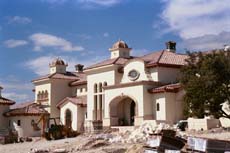Dense versus diluted places

Etruscan-Roman-Renaissance gate, Perugia, Italy

Colonial church, Las Trampas, New Mexico

Parish church, York, England

Recently built house for two people, Austin, Texas

Motel, Albuquerque, New Mexico
A historically diluted place may or may not have historical traces, but if they exist they are of no normative importance. Think of all the Hard Rock Cafes in various cities. Some of those franchises are in older buildings, and the historical ambiance may be attractive, but the social grammar of the place takes in the historical traces only as background decor. Historical dilution connects to role thinness, since it is because modern social roles are less substantial that modern places can choose to ignore the weight of history.
A dense place is does not make itself felt immediately; it is less pushy. It does not come at you; it is not aimed at just you; its live history gives it a momentum that does not need your constant support. This is not the case with an historically diluted attraction that which has to come at you in order to keep its reality, because its attraction is a force that is real only when it is being felt. When we find ourselves in such places, often we add complexity to our inhabitation by adding some ironic observation to our roles as consumer.Historical ensity is not identical to place complexity, but it can encourage complexity.